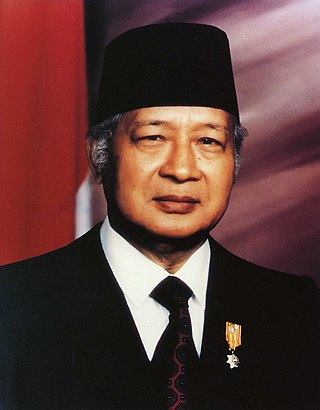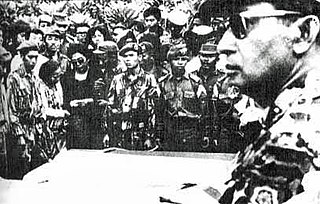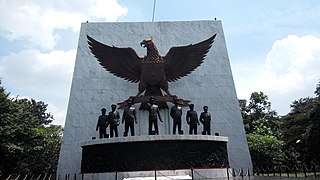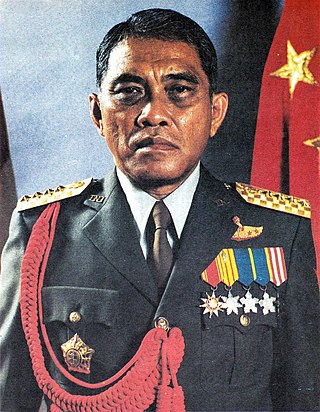
Suharto was an Indonesian military officer and politician, who served as the second and the longest serving President of Indonesia. Widely regarded as a military dictator by international observers, Suharto led Indonesia as an authoritarian regime from the fall of his predecessor Sukarno in 1967 until his resignation in 1998 following nationwide unrest. His 31-year dictatorship is considered one of the most brutal and corrupt of the 20th century, as he was central to the perpetration of mass killings against alleged communists, ethnic Chinese, irreligious people and trade unionists.

Sudharmono, also known by his nickname, Pak Dar, was an Indonesian politician and army officer, who served as the fifth vice president of Indonesia, under the New Order regime of president Suharto, serving from 1988 until 1993. Previously, he served in several positions in the government and military, including as the Chairman of Golkar, State Secretary of Indonesia, and a Lieutenant General in the army.

The State Intelligence Agency, commonly referred to as BIN, is Indonesia's primary intelligence agency. The BIN is also responsible for coordinating intelligence activities among various intelligence agencies, including military intelligence, police intelligence, prosecutors intelligence and other relevant entities.

The New Order describes the regime of the second Indonesian President Suharto from his rise to power in 1966 until his resignation in 1998. Suharto coined the term upon his accession and used it to contrast his presidency with that of his predecessor Sukarno.

Indonesia's transition to the New Order in the mid-1960s ousted the country's first president, Sukarno, after 22 years in the position. One of the most tumultuous periods in the country's modern history, it was the commencement of Suharto's 31-year presidency.

The Thirtieth of September Movement was a self-proclaimed organization of Indonesian National Armed Forces members. In the early hours of 1 October 1965, they assassinated six Indonesian Army generals in an abortive coup d'état. Later that morning, the organisation declared that it was in control of media and communication outlets and had taken President Sukarno under its protection. By the end of the day, the coup attempt had failed in Jakarta. Meanwhile, in central Java there was an attempt to take control over an army division and several cities. By the time this rebellion was put down, two more senior officers were dead.

General (Ret.) Leonardus Benjamin Moerdani was the ABRI Commander from 1983 to 1988 and also served as Indonesia's Minister of Defense and Security. He is famous due to his strong stance in many decisive situations in Indonesian political and social life. He was also significant as a leader who was Catholic in a predominantly Muslim community.

The Order of Eleventh March, commonly referred to by its syllabic abbreviation Supersemar, was a document signed by the Indonesian President Sukarno on 11 March 1966, giving army commander Lt. Gen. Suharto authority to take whatever measures he "deemed necessary" to restore order to the chaotic situation during the Indonesian mass killings of 1965–66. The abbreviation "Supersemar" is also a play on the name of Semar, the mystic and powerful figure who commonly appears in Javanese mythology including wayang puppet shows. The invocation of Semar was presumably intended to help draw on Javanese mythology to lend support to Suharto's legitimacy during the period of the transition of authority from Sukarno to Suharto.
The Davao Death Squad (DDS) is a vigilante group in Davao City, Philippines. The group is alleged to have conducted summary executions of street children and individuals suspected of petty crimes and drug dealing. It has been estimated that the group is responsible for the killing or disappearance of between 1,020 and 1,040 people between 1998 and 2008. The 2009 report by the CHR noted stonewalling by local police under Duterte while a leaked cable observed a lack of public outrage among Davao residents.

An extrajudicial killing is the deliberate killing of a person without the lawful authority granted by a judicial proceeding. It typically refers to government authorities, whether lawfully or unlawfully, targeting specific people for death, which in authoritarian regimes often involves political, trade union, dissident, religious and social figures. The term is typically used in situations that imply the human rights of the victims have been violated; deaths caused by legal police actions or legal warfighting on a battlefield are generally not included, even though military and police forces are often used for killings seen by critics as illegitimate. The label "extrajudicial killing" has also been applied to organized, lethal enforcement of extralegal social norms by non-government actors, including lynchings and honor killings.

The Indonesian occupation of East Timor began in December 1975 and lasted until October 1999. After centuries of Portuguese colonial rule in East Timor, the 1974 Carnation Revolution in Portugal led to the decolonisation of its former colonies, creating instability in East Timor and leaving its future uncertain. After a small-scale civil war, the pro-independence Fretilin declared victory in the capital city of Dili and declared an independent East Timor on 28 November 1975.

The insurgency in Aceh, officially designated the Rebellion in Aceh by the Indonesian government, was a conflict fought by the Free Aceh Movement (GAM) between 1976 and 2005, with the goal of making the province of Aceh independent from Indonesia. The aftermath of a strong military offensive in 2003 and the 2004 Indian Ocean earthquake and tsunami brought a peace agreement and an end to the insurgency.
This is a list of activities carried out by the U.S. Central Intelligence Agency in Indonesia.

Large-scale killings and civil unrest primarily targeting members of the Communist Party (PKI) were carried out in Indonesia from 1965 to 1966. Other affected groups included alleged communist sympathisers, Gerwani women, trade unionists, ethnic Javanese Abangan, ethnic Chinese, atheists, so-called "unbelievers", and alleged leftists in general. According to the most widely published estimates at least 500,000 to 1.2 million people were killed, with some estimates going as high as two to three million. The atrocities, sometimes described as a genocide or politicide, were instigated by the Indonesian Army under Suharto. Research and declassified documents demonstrate the Indonesian authorities received support from foreign countries such as the United States and the United Kingdom.

The Indonesian National Police is the national law enforcement and police force of the Republic of Indonesia. Founded on 1 July 1946, it was formerly a part of the country's military since 1962. The police were formally separated from the armed forces on 1 April 1999 in a process which was formally completed on 1 July 1999.
The Tanjung Priok massacre was an incident that occurred on 12 September 1984, in the port area of Tanjung Priok, Jakarta, Indonesia. Government reports give a total of 24 killed and 54 injured, while survivors report over 100 killed.
Preman is a term for Indonesian organized crime groups, encompassing street level criminals up through crime bosses. Premans are often perceived negatively throughout Indonesian society due to associations with violence and criminality. This root word is derived from a term which describes the "confluence of state power and criminality". However, organized crime in Indonesia has a more enduring and complicated history, as the confluence of crime syndicates with perceived legitimate political authority has a history extending as far back as the Mataram Kingdom. While associated with brigandage and theft, Indonesian crime syndicates have periodically acted as enforcers to maintain authority and order. The roles of the jago or jawara were particularly important during the Indonesian Revolution, as they often adopted political roles that helped consolidating the power of local authorities. Despite their significance to Indonesian history, syndicates are universally marginalized due to associations with violence and social illegitimacy.
Capital punishment is a legal penalty in Indonesia. Although the death penalty is normally enforced only in grave cases of premeditated murder, corruption in extreme cases can lead to the death penalty and the death penalty is also regularly applied to certain drug traffickers. Executions are carried out by firing squad.

The Attorney General's Office of the Republic of Indonesia is the competent authority to advise the Government of Indonesia on matters of law. It serves as the central organization for the Indonesian Public Prosecution Service. The Attorney General's Office is seated in the national capital Jakarta.
In November 2019, the gang rape and murder of a 26-year-old veterinary doctor in Shamshabad, near Hyderabad, sparked outrage across India. Her body was found in Shadnagar on 28 November 2019, the day after she was murdered. Four suspects were arrested and, according to the Cyberabad Metropolitan Police, confessed to having raped and killed the doctor.
















